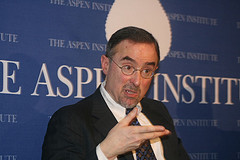
Hulk Hogan versus Andre the Giant. Photo (cc) by Luis Colás.
Previously published at WGBHNews.org.
Does Hulk Hogan’s invasion-of-privacy suit against the news-and-gossip site Gawker threaten the First Amendment? No. But the way his case is being paid for might.
Last week we learned that Peter Thiel, a Silicon Valley billionaire, had provided about $10 million to help fund Hogan’s case. Such third-party financing is legal, and it proved to be a sound investment: in March, a Florida jury found that Gawker had invaded Hogan’s privacy by publishing a video of him and a friend’s wife without permission and awarded him $140 million.
Now, first things first. If you care to immerse yourself in the details of the case, you will find all kinds of contradictory statements as to whether Hogan (real name: Terry Bollea) and his paramour, Heather Clem (wife of Bubba the Love Sponge Clem; and yes, that’s his real name), knew or didn’t know they were being recorded and did or didn’t expect that the video would somehow become public.
But the law involving invasion of privacy is reasonably clear. It can be traced back to an article that future Supreme Court justice Louis Brandeis and his law partner, Samuel Warren, wrote for the Harvard Law Review in 1890. The principle is explained succinctly in this warning to journalists published by the Reporters Committee for Freedom of the Press:
One who gives publicity to a matter concerning the private life of another is subject to liability to the other for invasion of privacy, if the matter publicized is of a kind that (a) would be highly offensive to a reasonable person; and (b) is not of legitimate concern to the public.
Hogan’s status as a public figure makes (b) a little iffy, and Gawker tried to argue that Hogan’s boasts about his sexual prowess made the sex tape newsworthy. That strikes me as the sort of issue that a jury could legitimately decide either way. As First Amendment expert Erwin Chemerinsky told the New York Times when the verdict was handed down, “I think this case establishes a very limited proposition: It is an invasion of privacy to make publicly available a tape of a person having sex without that person’s consent. I don’t think it goes any further than that and I do not see a First Amendment basis for claiming that there is a right to do this.”
There matters stood until May 24, when Ryan Mac of Forbes revealed that Thiel, a PayPal cofounder and “an eccentric figure in Silicon Valley who has advocated for teenagers to skip college and openly supported Republican presidential candidate Donald Trump,” was the money behind the Hogan suit. Thiel, Mac wrote, had been harboring a grudge against Gawker Media and its publisher, Nick Denton, since 2007, when Denton’s Valleywag site outed Thiel as gay.
The next day Thiel came clean in an interview with Andrew Ross Sorkin of the New York Times, saying, “I refuse to believe that journalism means massive privacy violations. I think much more highly of journalists than that. It’s precisely because I respect journalists that I do not believe they are endangered by fighting back against Gawker.”
As I’ve argued, Hogan’s case against Gawker was well within the bounds of existing privacy law. Moreover, it’s perfectly legal to finance someone else’s lawsuit. Yet numerous free-speech advocates have expressed horror at the Thiel revelation.
Washington Post media columnist Margaret Sullivan compared Thiel’s actions to the Edward Snowden affair and to Senator John Thune’s thuggish (my word, not hers) demand that Facebook account for perceived liberal bias in its Trending Topics feature.
Technology pundit Mathew Ingram of Fortune added that the Hogan case has now “become more about an attempt to bankrupt a publication that a billionaire investor dislikes for personal reasons. And that has disturbing implications for freedom of the press.”
Nick Denton himself, in an open letter to Thiel oozing with self-justifying obnoxiousness, wrote, “The best regulation for speech, in a free society, is more speech. We each claim to respect independent journalism, and liberty. We each have criticisms of the other’s methods and objectives. Now you have revealed yourself, let us have an open and public debate.”
Ingram and other defenders of Gawker point to some troubling aspects of Thiel’s involvement that do, in fact, have some important First Amendment implications. For instance: Hogan’s lawyer apparently insisted on a provision that Gawker Media’s insurance company not be allowed to pay the award, which strongly suggests that the motive behind the suit was to put Denton out of business rather than receive just compensation for the site’s transgressions.
In addition, Ingram notes, Thiel has said he’s backing several other lawsuits against Gawker. Although he hasn’t identified those suits, that may include one brought by V.A. Shiva Ayyadurai, who’s going after Gawker for calling his claim to have invented email fraudulent. Really?
The $140 million awarded to Hulk Hogan seems absurdly high, and the case is under appeal. Meanwhile, numerous reports suggest that Gawker Media is in serious financial trouble as a result of the case.
So we are faced with the prospect that a billionaire may secretly use his money to drive a news organization out of business. Gawker Media may be a singularly unsympathetic defendant, but that strikes me as the sort of money-fueled power imbalance that the First Amendment ought to expose, not enable. Is there anything we can do about it?
As Timothy B. Lee points out at Vox, “the law used to bar unrelated third parties from paying someone else to engage in litigation and financing a lawsuit in exchange for a share of the damages.” Unfortunately, it’s not likely in the current political climate that such a ban would be reimposed.
At the very least, though, efforts such as Thiel’s should not be secret. Denton’s lawyer should have been allowed to present information about how the lawsuit against Gawker was being financed, and to have an opportunity to question Thiel in front of the jury about his activities and motives.
What Warren and Brandeis wrote 126 years ago seems, if anything, even more applicable today:
The press is overstepping in every direction the obvious bounds of propriety and of decency. Gossip is no longer the resource of the idle and of the vicious, but has become a trade, which is pursued with industry as well as effrontery.
But Brandeis may yet come to Denton’s rescue. Whether Denton knew it or not, it was Brandeis he was channeling in his call for more speech. As Brandeis wrote in the 1927 case of Whitney v. California: “If there be time to expose through discussion the falsehood and fallacies, to avert the evil by the processes of education, the remedy to be applied is more speech, not enforced silence.”
So let Hulk Hogan sue. Let Peter Thiel finance that suit. But let it play out in the light of day so that all of us, including jurors, can weigh and assess everyone’s motives—not just Hogan’s, or Mrs. The Love Sponge’s, or Nick Denton’s, but Thiel’s as well. It’s not a perfect solution, but surely openness would help alleviate any free-speech concerns raised by Thiel’s surreptitious activities.









 Yes, we should all be skeptical about checkbook journalism, and Gawker is right up front about having paid Robert Thomas, a former friend and would-be business associate of balloon dad Richard Heene (photo).
Yes, we should all be skeptical about checkbook journalism, and Gawker is right up front about having paid Robert Thomas, a former friend and would-be business associate of balloon dad Richard Heene (photo).